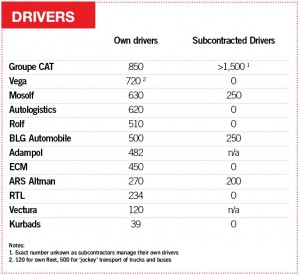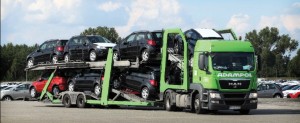 A survey carried out by Finished Vehicle Logistics revealed a sense of cautious optimism, but many points of contention among Europe’s automotive road hauliers.
A survey carried out by Finished Vehicle Logistics revealed a sense of cautious optimism, but many points of contention among Europe’s automotive road hauliers.
European car hauliers are still fragile from years of operating in a declining market for new vehicle deliveries across most of Europe and dealing with volatility in emerging markets like Russia. Indeed, they could struggle to cope with further market shocks or cost rises, but after making difficult cuts and adjustments, many providers now have stronger expectations for financial stability, with plans to at least maintain fleet levels if not expand. Making any sort of blanket statement about Europe as a whole is difficult, but for the most part the industry can be said to be enduring, rather than thriving.
A cautious optimism can be found in a Finished Vehicle Logistics survey carried out this autumn among European road carrier fleets, which drew responses from a variety of hauliers in Europe and Russia, as well as input from OEMs and trailer manufacturers. 
While carriers in the survey point to some improvements in their business environment, many also reveal significant challenges in the sector, some of which may be more endemic than cyclical. For example, most carriers comment that OEMs tend to contract with road hauliers for little more than a year, rather than committing to long-term contracts.
Regulatory issues across the European Union and the Russian Customs Union (Russia, Kazakhstan and Belarus) are another main point of contention for car hauliers, including the lack of universal standards for truck dimensions and loading lengths across the 28 EU member states, as well as complex licensing and toll roads in the Customs Union. Increasing costs for transport also remain difficult for carriers, with many operators reluctant or unable to invest in new equipment.
Fleet and capacity
Sales for new vehicles in Europe started to show signs of overall improvement towards the end of 2013, however the impact of such a recovery, if it lasts, may come later for vehicle logistics providers. Of the 14 car carriers who have given their respective companies’ statistics, the prevailing tendency seems to be one of slow, piecemeal improvement, with revenues increasing marginally or not at all in 2013 and similar outlooks for 2014 (see chart above). This situation appears to have weighed upon carriers’ plans for current and future fleet sizes, with few or modest plans to add capacity. 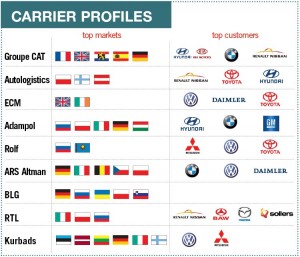
The fleet size of carriers in the survey ranged from fewer than 50 trucks to more than 500, with Groupe CAT’s 800-unit capacity the exception. Comparisons with ECG data from 2011 reveal that most carriers have shed capacity. With the exception of Groupe Cat, whose fleet has expanded dramatically thanks to a number of company acquisitions, the remaining providers in the survey exhibited an average 6% decrease over the past two years, with Mosolf’s fleet diminishing from 800 to 500 units, Vega’s from 120 to 100 units and BLG’s from 500 to 320 units (see chart on p30).
However, the part played by subcontractors may shed some light on these figures. Mosolf did not report hiring a subcontracted fleet in 2011, but now boasts one of 250. BLG tells a similar story, now hiring 200. This may demonstrate the continued efforts of carriers to mitigate risk on their balance sheets (see data here).
These adjustments appear to have helped carriers improve their fleet utilisation, as most in the survey claim their fleets are nearly completely active, with few to no trucks in lay-up.
There may even be cases where current capacity levels have not met demand for vehicle sales and production. Thomas Cullen, senior analyst at Transport Intelligence, says providers may need to shed more capacity in struggling southern European countries, as well as France and the Netherlands, however the strength in exports from Germany, as well as out of Spain and the UK more recently, may have left some OEMs with shortages in vehicle logistics capacity.
“Looking at the production figures from JLR [Jaguar Land Rover], it’s hard to believe it is making half a million cars a year. The growth in the UK is explosive and their system must be creaking,” says Cullen.
Yet overcapacity remains an issue in some regions. Drops this year in the Russian market follow several years of increases and appear to have caught out some who invested heavily in new equipment. As Russian Transport Lines’ sales specialist Anastasia Chupina comments, “There’s an overcapacity problem across the market, with a lack of new trucks and trailers, and the cost of fuel and equipment isn’t reducing; only increasing.”
A careful expansion
European carriers have been relying upon subcontracted fleets to meet short-term rises in demand, rather than making new investments, the survey suggests. Carriers including Adampol, ARS Altmann, Autologistics Group, BLG, Vega, Vectura, Rolf and Mosolf say that between 10-20% of their fleets are made up of subcontracted transporters. In the UK, for example, a recent change in the law allows car carriers, such as ECM, to subcontract foreign road carriers during the country’s peak March and September registration periods. 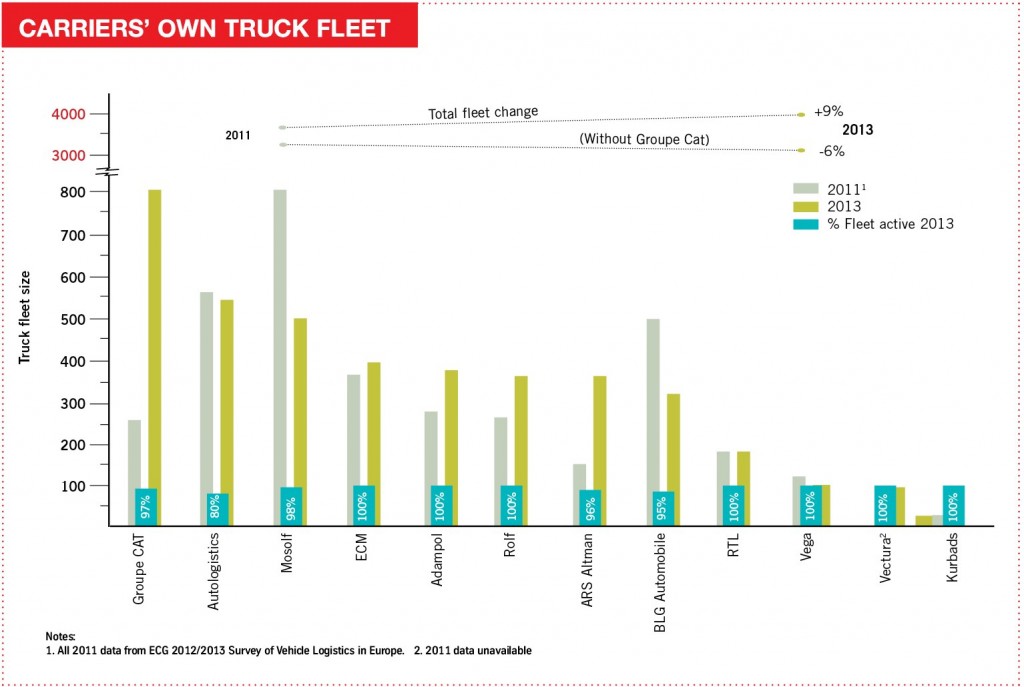
Despite this steady use of subcontracters, not all logistics providers use outsourced drivers for this equipment. Groupe Cat, Mosolf, BLG and ARS Altmann said they did, while others use their own drivers in the rented trucks. Some providers also incorporate subcontractors directly into their branded fleets. At BLG, for example, the 200 subcontracted carriers used by the group are designed specifically for the company, meaning that it would be impossible to identify on the road whether a trailer belonged to BLG or its subcontractors.
Although it has increased its use of subcontractors, BLG has also expanded its fleet, adding a further 20 trucks in 2013 to its current set of 500. Serving many east European countries, the company plans to invest in new trucking equipment on its home turf and also in Russia, according to managing director Michael Bünning.
However, BLG has been careful about adding new capacity. Bünning reveals that the company has also maintained its fleet by refurbishing existing vehicles. “We’re running a project called ‘body swap’, which means taking six- to seven-year-old trucks, purchasing a new chassis, renovating the body and trailer [including] sand blasting, new paint, new hydraulics, and allowing the ‘almost new’ truck to be operational for another six or seven years.”
Helicar operates a similar policy of fleet renewal, according to Vít Hrabánek, general and sales manager. “We continuously renew one truck a month,” he says.
Some providers have gone for outright expansion, including the acquisition of new companies and subsidiaries as well as trucks. Groupe CAT’s purchase last year of the Toquero Group added a large number of trucks to the company’s fleet on the Iberian Peninsula and in France, making it one of the largest for vehicle logistics on the continent. “We added a further 250 trucks to our operations, to serve the Spanish and Portuguese markets,” says communications manager Frédérick Vaglio.
Bureacracy abounds
European road carriers often cite ‘red tape’ as a major issue, including EU regulations and those for Russia and its neighbours, such as Belarus and Ukraine. With rules and restrictions on European carriers often in flux, logistics providers must be quick to amend their operations when authorities make a decision in Brussels or anywhere else at national or municipal level (such as cities restricting the movement of larger trucks).
Adampol’s commercial director, Barbara Koncewicz, says her company tries to adjust immediately to regulatory conditions and to search for opportunities to improve business operations within the changes.
“Our policy concentrates on giving OEMs and importers the opportunity to be more competitive. They are very sensitive to any political changes in the economy, which is why we carefully follow the news and react quickly, finding solutions to keep the flow of cars smooth and make the logistics ‘invisible’ for our customers,” she says. 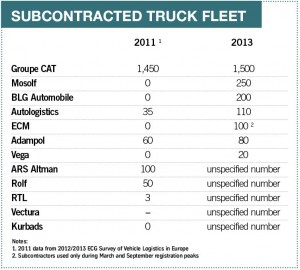
Weights and dimensions
Regular changes cited by carriers include those made to restrictions on load weight, which increase the overall cost of transporting cars to their final destination. The lack of standardisation prevalent across the EU relating to the maximum authorised dimensions of loaded car carriers remains challenging for operators. As noted consistently by the Association of European Vehicle Logistics (ECG), maximum allowable loaded lengths in Europe range from as low as 18.75 metres in Greece and certain east European countries, to greater than 25 metres in countries that allow the European Modular System (notably Sweden and Finland).
Most countries allow a range in between, but carriers encounter problems moving between countries with different allowances. The ECG has recommended a minimum allowable loaded length of 20.75 metres as the Euoprean Commission reviews weights and measures laws. But the EC has not been supportive and there are risks that border crossing limits could be imposed more strictly.
"Drivers always follow market trends, changing industries and companies. We focus on careful selection and avoid having a huge pipeline of new drivers" - Anastasia Chupina, Russian Transport Lines
Some countries have pushed for wider access for EMS trucks, for which there have been trials in the Netherlands and parts of Germany. However, this length remains controversial in many countries and would be impractical for vehicle deliveries in a number of European cities. The ECG has also pointed out that the EMS would be untenable for car carriers unless restrictions on weight were also lifted.
A history of tolls
Europe’s toll roads, motorway charges and vignettes often impact desired travel routes. Similar to the issues of allowable lengths, the amount of taxation that countries impose varies widely. Italy’s roads, for instance, are almost exclusively tolled, as is France’s autoroute system. Since 2005, the German maut system has charged trucks using the autobahn based on distance travelled, axles and emission category. However, Nordic countries, such as Denmark, Finland and Iceland, remain largely open-access and charge-free.
The landscape for road tolls is consistently changing across Europe, although the trend has generally been towards ‘user pays’ systems, wherein the end customer foots a heavier bill depending on weight and cargo, partly in return for a faster service. In July 2013, Belarus introduced the ‘Beltoll’, an automated toll for trucks from within the Customs Union that are laden with cargo weighing more than 3.5 tonnes; trucks from outside the Customs Union pay for goods lighter than 3.5 tonnes as well. France will also apply more charges to delivery trucks with its ‘Ecotax’, although its implementation was recently delayed. The Russian government recently announced that it would introduce 3,000km of toll roads by the end of 2016 in a bid to raise revenues for the country’s poor road conditions.
Fuel remains the most expensive component of transport for car hauliers. With prices on the rise across Europe and new vehicles expected to increase in value, a number of carriers in the survey say that the relationship between transport costs and the cost of the transported vehicle in question should be more mutually beneficial. For example, if fuel prices continue to rise along with the price of a new vehicle, yet logistics costs remain the same, carriers will inevitably encounter a financial bottleneck.
Another issue for carriers in Europe has been the lack of fully qualified drivers. It is expected that in Germany alone, 250,000 truckers will retire over the next decade, and only 10% of the resultant gap is expected to be filled by new drivers.
According to Ananth Srinivasan, team leader for off-highway market research at consultancy firm Frost & Sullivan, there is a big driver shortage in the trucking industry despite high unemployment rates in Europe. Srinivasan points to a combination of demographic factors and the job’s low appeal as contributing to the trend.
“Consequently, major hauliers are looking to retain the current population of drivers and are increasingly adopting driver-friendly measures in their operations,” says Srinivasan. “It is expected that trucks with advanced comfort and convenience features, such as seat system designs, advanced noise and vibration cancellation, in-cabin infotainment and cabin air-conditioning will gain prominence in the industry.”
Not all carriers are facing driver shortages, however. Barbara Koncewicz says that Adampol does not currently have any problems hiring drivers. “Most of the [driving] candidates already took appropriate qualification courses, [but] each new driver hired by Adampol takes three months training on loading and unloading procedures,” she says.
Koncewicz cites trouble filling driver vacancies back in 2003, when transport regulations were changing and many drivers didn’t possess the necessary qualifications, but
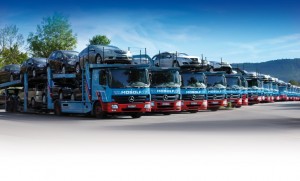
“Training and drivers’ courses were expensive,” adds Koncewicz. “At the time, the way we solved this problem was through hiring foreign drivers from Belarus and Ukraine; later still, the Labour Office financed training courses and the market was flooded with experts, and the problem disappeared.”
Other providers cite different strategies for recruiting and training drivers. Russian Transport Lines’ Anastasia Chupina says much of the issue in Russia is related to high turnover among drivers. “Drivers always follow market trends, changing industries and companies,” she says. “We focus on careful selection and avoid having a huge pipeline of new drivers.”
Latvian carrier Kurbads notes that it spends approximately three to four weeks intensively training new drivers, while Russia’s Rolf claimed to spend an annual Rb80,000 ($2,445) on the training and recruitment of each of its drivers.
Systemic problems
Carriers point to a number of perennial problems that they face, including a tendency toward short-term commercial arrangements, as well as high levels of empty backhauls. Adampol’s Barbara Koncewicz says contracts between carriers and OEMs or lead logistics providers (LLP) are rarely longer than one year. “Together with the high requirements of investments and quality offering [required of] the car carriers, such a short period of co-operation points only to one goal: cost savings on the OEM or LLP’s side.”
However, BMW’s Matthias Wellbrock, general manager for plant dispatch and vehicle distribution, maintains that the carmaker does have long-term partnerships with many of its 30 different carriers, a list that includes ARS Altmann, BLG, WWL, Bertani, Groupe CAT, Hodlmayr, Walon and DB Schenker.
“A high sense of co-operation and strategic partnership definitely exists between OEMs and carriers,” he says, “[which is] shown through long-term contracts to ensure future investments in equipment and extended support during critical situations, such as strikes. Solution-based co-operation is generally shown by our suppliers.”
Empty backhauls are also a common issue across the European industry, and this situation appears to have worsened with a growing split between domestic sales and exports for some parts of the continent, such as Spain, or even Germany in some cases. Wellbrock cites the imbalance of truck trades that have resulted from economic stagnation, particularly in west-east routes, such as between Germany and France or Spain, with the declines in those markets meaning there is less cargo for return loads.
Groupe CAT’s European fleet director, Patrice Grosset, claims there has been an increase in unbalanced flows across Europe in recent years, which he feels will lead to further consolidation among logistics players. “[There will be] a drop in players within the market – specifically the smallest [providers], led by growing expectations for productivity and quality control from OEMs.”
Regarding empty loads, Bill Pawluk, of Convertible Trailer Manufacturing, says that there is no reason why carriers should be running any empty miles in the industry, especially with the use of more flexible equipment and technology. Pawluk’s company, for example, has developed a car carrier that can switch between carrying vehicles or general cargo; the equipment is currently being tested in various European markets.
IT potential
Insufficient utilisation of vehicle carrier loads can be as problematic for vehicle logistics provider and carmakers as can empty miles, says DB Schenker’s rail automotive expert Christian Lang. “For truck transportation it is a prerequisite to achieve a so-called ‘network utilisation share,’” Lang says. “This needs to be at a level of at least 70% in order to achieve cost coverage.”

One possible answer to low utilisation and backhauls could lie in IT software that increases tracking capabilities. The advantage of GPS tracking for trucks and the ability of drivers to communicate with each other have long been a point of agreement among ECG members.
Another concept discussed both in the industry and among policymakers has been ‘e-Freight’, which includes automating more transport and billing procedures in the supply chain. A project for e-Freight has been funded by the European Commission together with industry stakeholders. While industry players express interest in such paperless processes, it remains challenging to implement a universal paperless exchange across so many separate countries with their own individual regulations. However, creating some level of standardisation and uniformity in which information can be converted across different providers and transport modes would be important in a European context.
The GS1 system, for example, operates within many countries and provides carriers with ID numbers, barcodes, radio frequency identification, electronic data interchange (eCom), and a global data synchronisation network (GDSN). Similar to sending an e-mail, though with added security, sharing information electronically emerged as the defining point of agreement among carriers keen to witness greater harmonisation between OEMs, trailer builders and providers. This is one example of attempts at progress: an alternative, more universal system of tracking, which is something that ECM’s managing director Ray MacDowall feels is necessary.
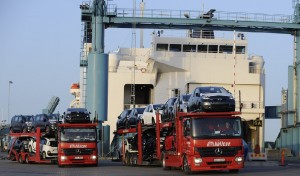
As the largest privately owned UK-based car carrier, with a fleet of over 400 vehicles, MacDowall claims the main challenge for all carriers is the same, regardless of country: surving in an industry where transport levels are declining and operating costs continue to increase. “Many companies have invested in IT in a bid to gain efficiencies,” he says, “but the general lack of confidence has stifled investment, including developments in IT.”
It’s not easy going green
Carriers have also expressed concern over emissions, especially environmental legislation that could influence costs. The European Commission has noted that heavy-duty vehicles contribute to around one quarter of all carbon dioxide emissions from road transport across member states – 6% of total EU emissions. As the economy recovers, this is only set to increase.
Regulations for emissions and fuel efficiency for commercial vehicles are already tight and tightening in the EU, with Euro VI requirements coming into force in 2014-2015, but carriers and trailer manufacturers – such as major players Lohr and Rolfo within Europe – will also be affected by European-wide plans to install equipment designed to reduce CO2, as such equipment could raise investment and production costs.
This issue extends to problems relating to fuel, where legislation is also set to increase costs. In 2012, a new directive stated that, by 2020, one in every ten litres of fuel sold in the EU must eschew fossil fuels in favour of ‘sustainable alternative biofuels’. Carriers point to ever-more stringent methods of controlling vehicle exhausts across Europe, which produce further costs for vehicle logistics providers trying to adhere to environmental pressure.
Some examples of fuel-saving technologies include diesel catalysts, which reduce the levels of nitrogen oxide produced by a truck, as well as particulate traps. Each new piece of mandatory legislation brings further costs for truck OEMs.
Fuel-saving technology and eco-driving are now commonplace, says ECM’s Ray MacDowall, although he feels that carriers aren’t benefitting from any of the cost savings.
“It seems all the cost-saving benefits that could be made from such activities have been passed on to OEMs and absorbed into the rate reductions of recent years. However, during this process, investment by LSPs has been stifled and the continuing lack of it is starting to impact upon capacity, especially in markets like the UK where economic recovery is now well established.”
This sense of being ‘stifled’ is an important one on which to conclude. There are, given the many issues facing European car hauliers today, some signs of growth. However, the shortfall in levels of new equipment remains a concern for carriers and OEMs alike. As the demand for new cars increases, even gently, it should follow that the European market for hauliers invests as well. Yet with rising fuel prices and carriers unwilling to invest substantially in new models, as well as increasing legislation surrounding hauliers’ movements, it may yet be a further decade or more before the industry returns to form.
































